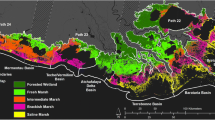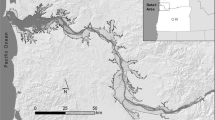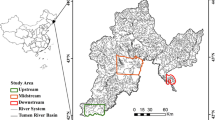Abstract
Patterns in coastal wetland loss in the northern Gulf of Mexico were examined using aerial imagery from 1955–56 and 1978. Five qualitative types of wetland changes are evident: (1) spoil bank-parallel pond formation, (2) pond formation with apparent random distribution for the smallest ponds, but very clumped distribution for larger ponds, (3) semi- or complete impoundment resulting in open water formation, (4) cutting off of stream channels upstream of where a spoil bank crosses a natural channel, and (5) erosion at the land-water interface. Only ponds <20 ha formed and disappeared in the interval, and it is clear that wetland breakup, not erosion at the pond-lake edge, is the dominant form of wetland-to-open water conversion. Canals and their spoil banks are spatially related to wetland-to-water conversion which is evident up to 2 km away from those man-made features. The indirect impacts of canals and spoil banks vary regionally, for example, with sediment compaction rates that increase with increasing sediment deposition. These results are consistent with the hypothesis that canals and spoil banks are a major factor driving wetland loss rates because they change wetland hydrology.
Similar content being viewed by others
Literature Cited
Baumann, R. H. and R. E. Turner. In press. Direct Impacts of Outer Continental Shelf Activities on Wetland loss in the central Gulf of Mexico.Environmental Geology and Water Science.
Cowan, J. andR. E. Turner. 1989. Modeling wetland loss in coastal Louisiana: Geology, geography, and human modifications.Environmental Management 12:827–838.
Cowardin, L. M., V. Carter, F. C. Golet, and E. T. LaRoe. 1979. Classification of wetlands and deepwater habitats of the United States. U.S. Fish and Wildlife Service, FWS/OBS-79/31. Washington, D. C. 103 p.
Craig, N. J., R. E. Turner, andJ. W. Day, Jr. 1980. Wetlands losses and their consequences in coastal Louisiana.Zeitschrift für Geomorphologie Neue Folge (Supl.). 34:225–241.
Frazier, D. E. 1967. Recent deltaic deposits of the Mississippi River, their development and chronology.Transactions Gulf Coast Association of Geological Societies 17:287–315.
Kesel, R. H. 1988. The decline in the suspended load of the lower Mississippi River and its influence on adjacent wetlands.Environmental Geology and Water Science 11:271–281.
Meade, R. H. and R. S. Parker. 1985. Sediments in Rivers of the United States. National Water Supply Summary. U.S. Geological Survey Water-Supply Paper 2275. 467 p.
Scaife, W. B., R. E. Turner, andR. Costanza. 1983. Recent land loss and canal impacts in coastal Louisiana.Environmental Management 7:433–442.
Swenson, E. M. andR. E. Turner. 1987. Spoil banks: Effects on coastal marsh water level regime.Estuarine, Coastal Shelf Science 24:599–609.
Turner, R. E. 1985. Coastal land loss, canals and canal levee relations in Louisiana. U.S. Fish and Wildlife Service, Office of Biological Services, FWS/OBS 85/14. 58 p.
Turner, R. E. and D. R. Cahoon (eds.). 1987. Causes of Wetland Loss in the Coastal Central Gulf of Mexico. Vol. 1. Executive Summary, Vol. 2. Technical Narrative, Vol. 3. Appendices. Final report submitted to Minerals Management Service, New Orleans, Louisiana. Contract No. 14-12-001-30252. OCS Study/MMS 87-0119. 536 p.
Turner, R. E. and C. Neill. 1984. Revisiting impounded wetlands after 70 years, p. 309–322.In R. J. Varnel (ed.), Proc. Water Quality and Wetlands Management Conference. Louisiana Environmental Professionals Association New Orleans, Louisiana.
Walker, H. J., J. M. Coleman, H. H. Roberts, andR. S. Tye. 1987. Wetland loss in Louisiana.Geografiska Annaler 69A: 189–200.
Wicker, K. M. 1980. Mississippi Deltaic Plain Region Ecological Characterization: A Habitat Mapping Study. A User’s Guide to the Habitat Maps. U.S. Fish and Wildlife Service, Office of Biological Services, FWS/OBS-79/07. Slidell, Louisiana. 45 p, appendices, 464 maps.
Wicker, K. M. 1981. Chenier Plain Region Ecological Characterization: A Habitat Mapping Study. A User’s Guide to the Habitat Maps. Louisiana Coastal Resources Program, Louisiana Department of Natural Resources. Baton Rouge, Louisiana. 45 p, appendices, 53 maps.
Author information
Authors and Affiliations
Rights and permissions
About this article
Cite this article
Turner, R.E., Rao, Y.S. Relationships between wetland fragmentation and recent hydrologic changes in a Deltaic Coast. Estuaries 13, 272–281 (1990). https://doi.org/10.2307/1351918
Received:
Accepted:
Issue Date:
DOI: https://doi.org/10.2307/1351918




